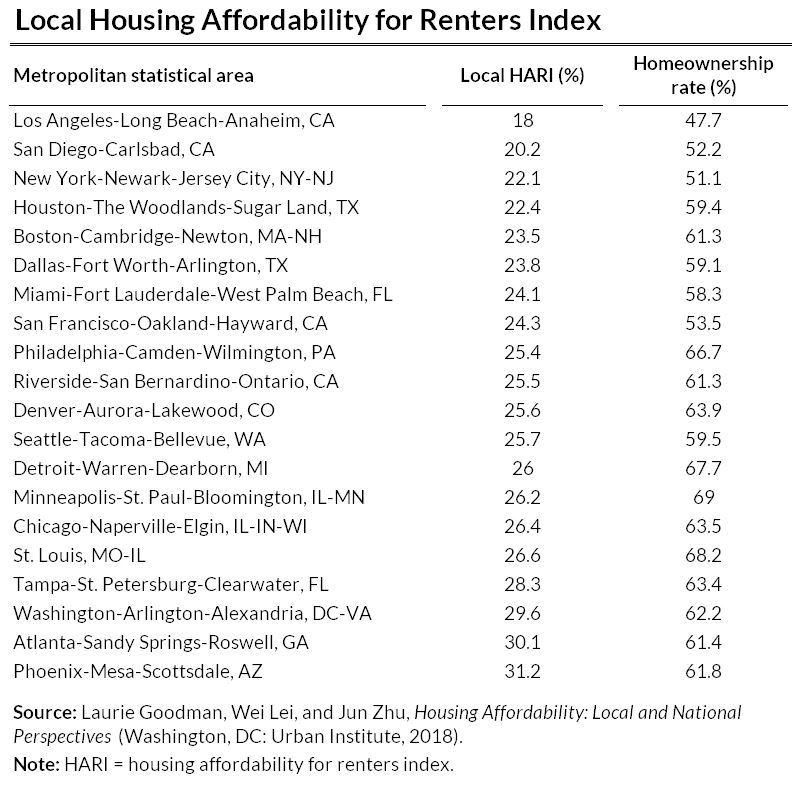
<p>Stephanie O'Brien inspects a bedroom in a home for sale during an open house on May 28, 2013 in San Francisco, California. Photo by Justin Sullivan/Getty Images.</p>
To address a critical flaw in current measures of homeownership affordability, we recently developed a new measure: the housing affordability for renters index (HARI). The HARI examines the 20 most-populous US metropolitan statistical areas (MSAs) and reveals a few surprises about some of these cities. For instance, San Francisco, Seattle, Washington, DC, are more affordable for local renters than other measures indicate.
Our index also shows that, nationwide, more than one in four renters have incomes that put homeownership within reach.
Flaws in current affordability measures
Current measures of homeownership affordability focus on median incomes and median home prices, both of which fail to provide information about the distribution of the incomes and area home prices.
Consider two housing markets with the same income distribution and the same median home price. One market has a broad home price distribution, with many homes at the both the low and high end of the scale, and the other has a narrow distribution. True housing affordability is likely to be better in the market with the broader distribution, as low-income families can afford homes.
Moreover, in some markets, the median might not represent the market, as the distribution may be skewed. A more accurate picture of affordability emerges if we consider the entire income distribution and home prices instead of a median metric.
Conventional measures are also flawed because they consider all households without distinguishing between owners and renters. But renters make the choice about renting or buying.
Introducing the HARI
Our new index focuses only on renters’ ability to become homeowners, comparing renters in each income decile with recent homebuyers in the same decile. We developed two HARI indexes:
- The local HARI shows how affordable homeownership is to current renters in the 20 most-populous MSAs. A local index of 25 percent indicates that 25 percent of renters in a given MSA earn enough to purchase a house in that area. The local HARI ranges from 18 to 31 percent.
- The national HARI shows in which of the 20 most-populous MSAs will migrating renters have the best chance of being able to afford to buy a home. The national HARI ranges from 9 to 31 percent, depending on the region into which the renter might move, assuming the renter keeps his or her current income.
The local index reveals the biggest surprises. The Washington, DC, metropolitan area is “severely unaffordable” by at least one traditional measure, but our index reveals that 30 percent of local renters can afford homes in the area, nearly double the 17 percent of national renters with incomes similar to those of DC homebuyers.
Renters moving to the area might find it difficult to afford a home there, but one-third of renters in the area have the necessary incomes.

San Francisco is equally surprising. Only 9 percent of national renters could afford to buy a home in San Francisco, but nearly one in four local renters have incomes that match those of recent local homebuyers.
In Seattle, one in four local renters can afford homes, while only 18 percent of national renters can match or exceed the incomes of recent homebuyers.
The national index is less surprising. The city where migrating renters would have the hardest time is San Francisco, where only 9 percent of current national renters have incomes at or above the incomes of recent San Francisco homebuyers.
The best chance for homeownership for a migrating renter is in St. Louis, where 31 percent of current national renters have incomes that match or exceed that of recent local homebuyers.

Owning a home remains the most reliable way for American families to build wealth and is often financially better than renting. By improving on current affordability measures , our new housing affordability for renters index helps policymakers better understand how and where more families can access homeownership.
Let’s build a future where everyone, everywhere has the opportunity and power to thrive
Urban is more determined than ever to partner with changemakers to unlock opportunities that give people across the country a fair shot at reaching their fullest potential. Invest in Urban to power this type of work.